|
Changes
Although I have tried hard to stay close to the original series in terms of
plot, format, and characterization, this is not to say that there have been no changes in this virtual Season Four.
Some are designed to update the show. Others correct what I (and other fans) see
as flaws in the way the original series was written. There are also some changes that
can be excused on the grounds that they are only the sorts of alterations you get between
seasons on real television. Undoubtedly, though, there is some residuum: no fan is
without bias; and one of the problems is that you never recognize it in your own writing.
Still, I have striven hard to give the impression that what you are “watching” is the
real Forever Knight.

Continuity:
The original Forever Knight series was like an anthology of short stories all of which were
about the same characters. Things just appeared out of the blue: in the final
season, for example, we were suddenly told mid-season that the parents of Nick’s partner,
Detective Tracy Vetter, were well into a
divorce. Unfortunately, this means that things
which ought to impact strongly on the characters do not have the same significance for the
viewers, especially if the script writers then never refer to them in subsequent episodes.
Indeed, in this type of television series, there is no sense that events in one episode,
even major events, have any long-term consequences. The exception, of course, is killing a
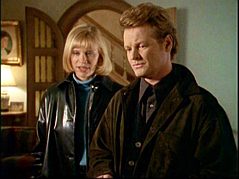 character off when the actor leaves the series—but there the motivation for change comes
from outside.
character off when the actor leaves the series—but there the motivation for change comes
from outside.
Originally, I had no intention of changing the way the series
operated. I was just writing individual episodes, using plots that had occurred to
me while the series was still on. Even after a couple of years, when I had written about
a dozen shows and had decided to assemble them into a season, I still did not intend to add
continuity. It did not seem authentic. But, as time passed, it became more and
more obvious that pretty well all TV shows were including at least some degree of
continuity. So sticking to the old format started to seem downright silly. After
all, if Forever Knight hadn’t been cancelled, it would probably have eventually
been affected by current trends. If it had ever been revived, it would have been
updated.
Nevertheless, I want to stress that I don’t want to alter the
general feel of the show. I’ve kept the main plot of each episode self-contained, except
for the two-part season premiere; and I’ve tried for variety. There’s no “big story” or
“five-year arc”. Mostly what I’ve added is continuity of characterization, and little
subplots involving the relationships between the characters.
Return to Top

Consistency:
One of the irritating things about the original series is its chronic
inconsistency. Of course, nitpickers can always find fault; and any show can shift
slightly over time as its premise is refined. But Forever Knight had more than
its fair share of problems.
 There were a variety of different interpretations of the nature of vampirism. Sometimes
they were handled this way and sometimes that. All depended on the impact on
the story told in the individual episode, without regard for the effect over the series as a
whole.
There were a variety of different interpretations of the nature of vampirism. Sometimes
they were handled this way and sometimes that. All depended on the impact on
the story told in the individual episode, without regard for the effect over the series as a
whole.
 There were occasional historical inaccuracies—most notoriously, perhaps, a reference
to Nick having helped someone at the Battle of Hastings, which was fought in 1066, years before
he could have been born.
There were occasional historical inaccuracies—most notoriously, perhaps, a reference
to Nick having helped someone at the Battle of Hastings, which was fought in 1066, years before
he could have been born.
 There were also a number of nit-picky inconsistencies, such as whether Nick’s
first partner, Don Schanke, did or did not have a
mother-in-law alive.
There were also a number of nit-picky inconsistencies, such as whether Nick’s
first partner, Don Schanke, did or did not have a
mother-in-law alive.
Naturally, I have attempted to avoid these problems—with what success I
cannot justly tell myself. Inconsistencies from the original series can sometimes be
resolved with a tad of ingenuity.
Return to Top

 Canadian Content:
Canadian Content:
The original Forever Knight also had a problem with Americanisms. The show was
devised in the States; and the original pilot was shot there, and its story
set there. Only when the series got the go-ahead was production moved to Canada and the series re-set in Toronto; and, although the pilot was rewritten, no consistent attempt was made to alter content that was relevant only
to its original setting.
Nor did the problem go away. Forever Knight may have
been filmed and set in Canada, but many of the people involved in writing it were still
American, and the show was primarily aimed at American syndication, despite having had, in its
first season, slightly different versions for the German and Canadian markets. There is,
therefore, a disconcerting foreign flavour to the series, at least from the perspective of a
Canadian viewer. For example, when suspects are cautioned in Canada, they are not given
the American “Miranda” warning. As in Britain, there is a different wording, though to
the same intent.
Other anomalies involve inconsistences between the Toronto of
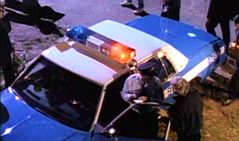 Forever Knight and the Toronto in which I live. Many of these involve the
depiction of the Toronto Police
Force. Trivial, yet visually striking, is the difference in the colour of the police cars, which
in the real Toronto are all white, but in the Toronto of Forever Knight are blue-and-white.
More important, as a Homicide detective, Nick should by rights be
working, not at the 96th Precinct on Queen Street, but out
of Police Headquarters on College Street, which is two subway stops away. And most
Forever
Forever Knight and the Toronto in which I live. Many of these involve the
depiction of the Toronto Police
Force. Trivial, yet visually striking, is the difference in the colour of the police cars, which
in the real Toronto are all white, but in the Toronto of Forever Knight are blue-and-white.
More important, as a Homicide detective, Nick should by rights be
working, not at the 96th Precinct on Queen Street, but out
of Police Headquarters on College Street, which is two subway stops away. And most
Forever
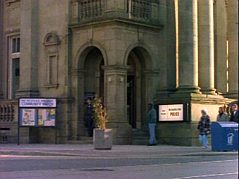 Knight fans know, of course, that the real Toronto police force does not have precincts:
it has divisions. But, as well, Nick’s boss would not have the rank of captain.
On the real police force, the ranks are (in order) Chief, Deputy Chief, Staff
Superintendent, Superintendent, Staff Inspector, Inspector,
Staff/Detective Sergeant, Sergeant/Detective, and Constable. (The similarity
to police ranks in Britain is, of course, not a coincidence.) A last point—there is no
Police Commission, but rather a Police Services Board.
Knight fans know, of course, that the real Toronto police force does not have precincts:
it has divisions. But, as well, Nick’s boss would not have the rank of captain.
On the real police force, the ranks are (in order) Chief, Deputy Chief, Staff
Superintendent, Superintendent, Staff Inspector, Inspector,
Staff/Detective Sergeant, Sergeant/Detective, and Constable. (The similarity
to police ranks in Britain is, of course, not a coincidence.) A last point—there is no
Police Commission, but rather a Police Services Board.
There is, however, a problem with correcting this sort of thing to
bring Forever Knight more in line with the actual situation in the real City of Toronto.
Some of the anomalies are so entwined in the series—mentioned so frequently, in so
many episodes—that altering them would produce stories that, from the perspective of a long-time fan, would seem somewhat inauthentic. To a certain degree, then, one simply has to accept that
Forever Knight, like all fiction, has its own secondary world; and, furthermore,
that the Toronto in which Nick Knight lives differs from the one in which I live in
more than just the existence of vampires.
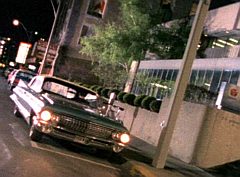
So there is no changing the fact that, in the world of Forever
Knight, the police force has blue-and-white squad cars, precincts instead
of divisions, and captains instead of superintendents. Equally, there is a radio station
called CERK, and a tabloid newspaper called the Metropolitan Examiner (neither of which exists
in the real Toronto either). However, there are other things mentioned only once or
twice; and I see no reason not to bring them closer in line
to reality. After all, they did get some things right: the police
pathologist in the series, Dr. Natalie Lambert,
does indeed have her office in the Coroner Building on Grenville Street, just as she would if
she were working in the real Toronto.
Return to Top

Supernatural:
I’ve largely cut out the supernatural stuff. Now that Buffy the
Vampire Slayer and its spin-off Angel are so well-known (and Twilight has become a
raving success), it seems important to
differentiate the world of Forever Knight. It should play to its own strengths.
That to me means taking an essentially realistic approach. The existence of
vampires is now the only supernatural element. No more haunted houses or
demonic possession. That’s the purview of other vampire series.
By the same token, no melodrama. I think vampires work
better when they’re played straight, especially when they’re supposedly a secret race hiding in
an otherwise realistically depicted version of our own world. So Nick works mostly pretty
straightforward cop-show type cases.
I have, however, kept the metaphysical aspects of vampirism.
There’s obviously more going on here than just the purely physiological.
Return to Top

Changes in Cast:
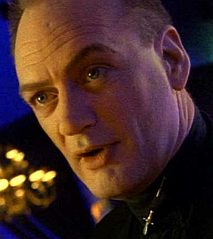
|

|
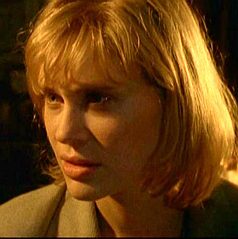
| |
LaCroix
|
Dr. Natalie Lambert
|
Det. Tracy Vetter
|
I’ve based Season IV on Season III.
That means that the regular cast for that season is back, playing the same
characters that
they played the previous year. Nick’s partner is still
Det. Tracy Vetter; their boss is Capt. Joe Reese;
and they work with Dr. Natalie Lambert, the forensic
pathologist. The vampire who
brought Nick over, LaCroix, is still the owner of the Raven
nightclub, and still has a late night radio show, which he hosts as “the Nightcrawler”.
Since in my version of FK reality, the series wasn’t
cancelled, the penultimate episode of Season III,
“Ashes to Ashes”, had a somewhat
different plot. In FK4, therefore, the two younger
vampires Javier Vachon and his daughter
Urs are not dead (or, at any rate, they are still undead).
Vachon appears in every episode, and Urs in most of them. That is a shift from
Season III, where Vachon appeared in only ten episodes, and Urs was a
minor recurring character. But that is the sort of change that often occurs in
real shows, budget permitting.
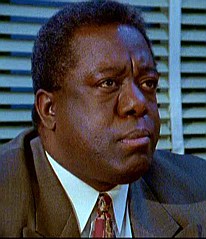
|
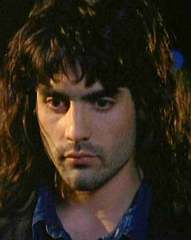
|
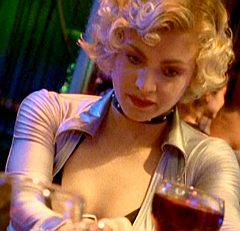
| |
Capt. Joe Reese
|
Javier Vachon
|
Urs
|
Return to Top

Changes in Sets:
The permanent sets for Season III included
Nick's apartment,
the squad room,
the Raven,
Natalie's office, and
Tracy's apartment—all
of which are, of course, still around in
FK4.
 In the antepenultimate episode, “Francesca”, we saw a set for the
abandoned church where
Vachon lives. It doesn’t seem quite the same as the sets seen in previous episodes, so
I’m assuming that at some point he decided to move down to the basement, probably to avoid
windows. At any rate, that set is now permanent.
In the antepenultimate episode, “Francesca”, we saw a set for the
abandoned church where
Vachon lives. It doesn’t seem quite the same as the sets seen in previous episodes, so
I’m assuming that at some point he decided to move down to the basement, probably to avoid
windows. At any rate, that set is now permanent.
 I have also resurrected the set for Natalie’s
apartment, as it was seen in Season II (although, in truth, that set was actually converted
into Tracy’s apartment for the final season of the show).
I have also resurrected the set for Natalie’s
apartment, as it was seen in Season II (although, in truth, that set was actually converted
into Tracy’s apartment for the final season of the show).
 And I’ve added a set for LaCroix, up in his apartment above
the Raven. Since “Ashes to Ashes” happened differently in
FK4, I’ve not used the set from the aired version; instead, I’ve
designed my own. It’s a study. (Given the tone of his Nightcrawler broadcasts, he seems
pretty well read.)
And I’ve added a set for LaCroix, up in his apartment above
the Raven. Since “Ashes to Ashes” happened differently in
FK4, I’ve not used the set from the aired version; instead, I’ve
designed my own. It’s a study. (Given the tone of his Nightcrawler broadcasts, he seems
pretty well read.)
Adding new sets for a new season is, of course, a pretty common practice in
real TV shows—again, of course, budget permitting. Where, exactly, they’d fit them in
on the soundstage is outwith my ken.
Return to Top

Budget:
As you may have gathered, I’ve increased the amount of money available to
the people making the show. Not that you’re suddenly going to get a vampire version of
Law and Order. But I’ve worked on the assumption that the show might not only
have been picked up for another season, perhaps on yet another network, but it might even have
been given a budget raise (probably the unlikeliest of all the deviations I’ve made). The
episodes of FK4 are written, therefore, with an eye to their
costing about the same as those of Forever Knight’s first year.
How far do I manage to stay on budget? Well, as I don’t
actually have to build sets, go on location, hire actors, costume them, or go through the
whole production/postproduction process, and as I have never been involved in this process in
the real world, I can’t possibly say. But, within general guidelines (such as counting
the number of additional speaking parts I put in, and comparing that with the number in Season I
episodes), I have tried to keep costs down. More or less, anyway—at least in most
episodes. After all, if you’re going to play a game, you should play by the rules.
|